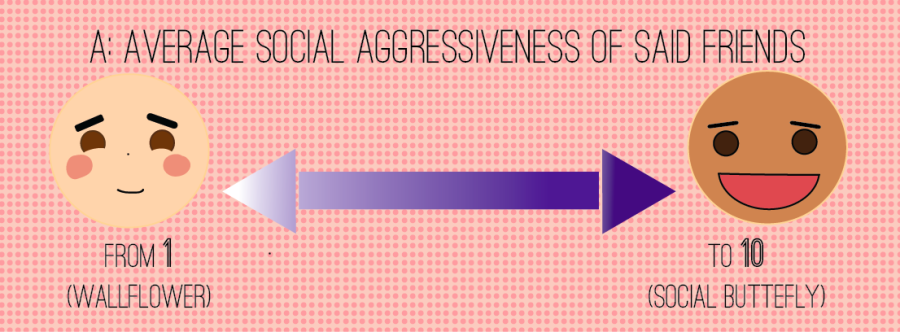Fun squared: an algorithmic approach to school dances
Determine whether you will have fun at the dance using this handy-dandy chart that maps the social aggressiveness of your friends!
Do the words “Harker Homecoming” fill you with dread? Do you cringe at the idea of being surrounded by a crowd of people who are not part of your Physics study group? Do you feel the compulsion to analyze the rhyme scheme in Nicki Minaj songs?
With Harker Homecoming approaching, you might be thinking, “Wow, I do not have the social skills to survive the dance.” And you would be correct.
Luckily for you, the brilliant and underpaid scientists at harkeraquila.com have derived a mathematically sound, beta-tested algorithim to help you enjoy yourself at a school dance.
First, let’s define our variables.
f = amount of fun at dance
v = volume of friends with you at dance
a = average social aggressiveness of said friends, assuming you have any
C = coefficient of fun. For all intents and purposes, C = 25 units, the approximate amount of fun you have listening to your favorite song whilst eating your favorite food. Any amount of f < C will not be enough to constitute a “good time” at a dance because you would have had more fun staying at home.
What are our goals?
As a casual dance attendee, your goal is to make sure that f ≥ C. Because of the static forces of loneliness and awkwardness, you will not start to have fun at a dance until after you’ve accumulated enough activation energy to cross the threshold into a good time.
You can increase your f value to ≥ 25 (remember C = 25) using the equation: f = v*a.
Elaboration on quantities.
a (average social aggressiveness of friends) ranges as follows: 1 < a < 10. In layman’s terms, a is measured on a scale of 1 to 10, 1 being shrinking violet, and 10 being social butterfly. The general population falls into a bell curve peaking at 5.
v (volume of friends) refers to the number of friends who will stick with you throughout the entire dance. To avoid skewing your calculations, avoid including extraneous variable in your calculations: friends who will stop by a few times during the dance, but will likely spend the majority of their time at the photobooth/with their date/with cooler friends.
In order to have fun at a dance, you must either increase the number of friends going with you or find friends socially aggressive enough to force you into situations you wouldn’t feel comfortable enough to initiate on your own.
For example, if you bring 5 friends who are all average on the social aggressiveness scale (5), you will have exactly met the activation energy requirement to have fun. Contrarily, you could bring 3 friends with a very gregarious average social aggressiveness (9) and also meet the requirement of f ≥ C.
Answer Key:
a = (a1+a2+a3+a5)/4, a = (3+7+5+4)/4, a = 4.75, v = 4
(note: Friend 4 excluded because he/she is an extraneous variable)
f = a*v f = 4.75*4 f = 19.
Is f ≥ C = 25?
No. Your f value is less than 25, and you do not cross the threshold into fun. You feel slightly put out and disappointed because you got dressed up for nothing. It’s okay, we’ve all been there.
Thankfully, this is just a practice problem. With the right components, you can calculate your way out of ever being in this position.
As you can see, it doesn’t take human connections or social skills to have fun at a dance. Using this algorithm, you can approach Harker Homecoming the way you approach everything else: with math.

Meilan Steimle (12) is co-Editor-in-Chief of the Winged Post. She was a reporter her freshman year, Winged Post Opinion Editor her sophomore year and Winged...


















![“[Building nerf blasters] became this outlet of creativity for me that hasn't been matched by anything else. The process [of] making a build complete to your desire is such a painstakingly difficult process, but I've had to learn from [the skills needed from] soldering to proper painting. There's so many different options for everything, if you think about it, it exists. The best part is [that] if it doesn't exist, you can build it yourself," Ishaan Parate said.](https://harkeraquila.com/wp-content/uploads/2022/08/DSC_8149-900x604.jpg)




![“When I came into high school, I was ready to be a follower. But DECA was a game changer for me. It helped me overcome my fear of public speaking, and it's played such a major role in who I've become today. To be able to successfully lead a chapter of 150 students, an officer team and be one of the upperclassmen I once really admired is something I'm [really] proud of,” Anvitha Tummala ('21) said.](https://harkeraquila.com/wp-content/uploads/2021/07/Screen-Shot-2021-07-25-at-9.50.05-AM-900x594.png)







![“I think getting up in the morning and having a sense of purpose [is exciting]. I think without a certain amount of drive, life is kind of obsolete and mundane, and I think having that every single day is what makes each day unique and kind of makes life exciting,” Neymika Jain (12) said.](https://harkeraquila.com/wp-content/uploads/2017/06/Screen-Shot-2017-06-03-at-4.54.16-PM.png)








![“My slogan is ‘slow feet, don’t eat, and I’m hungry.’ You need to run fast to get where you are–you aren't going to get those championships if you aren't fast,” Angel Cervantes (12) said. “I want to do well in school on my tests and in track and win championships for my team. I live by that, [and] I can do that anywhere: in the classroom or on the field.”](https://harkeraquila.com/wp-content/uploads/2018/06/DSC5146-900x601.jpg)
![“[Volleyball has] taught me how to fall correctly, and another thing it taught is that you don’t have to be the best at something to be good at it. If you just hit the ball in a smart way, then it still scores points and you’re good at it. You could be a background player and still make a much bigger impact on the team than you would think,” Anya Gert (’20) said.](https://harkeraquila.com/wp-content/uploads/2020/06/AnnaGert_JinTuan_HoHPhotoEdited-600x900.jpeg)

![“I'm not nearly there yet, but [my confidence has] definitely been getting better since I was pretty shy and timid coming into Harker my freshman year. I know that there's a lot of people that are really confident in what they do, and I really admire them. Everyone's so driven and that has really pushed me to kind of try to find my own place in high school and be more confident,” Alyssa Huang (’20) said.](https://harkeraquila.com/wp-content/uploads/2020/06/AlyssaHuang_EmilyChen_HoHPhoto-900x749.jpeg)



